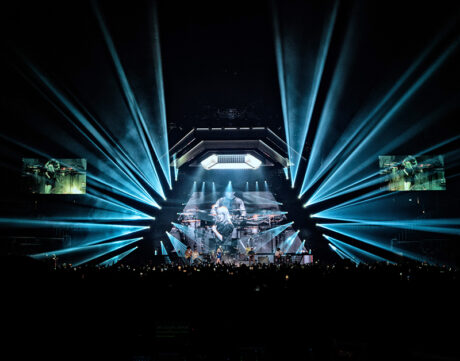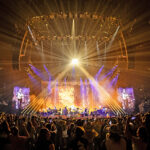
The pop/punk trio Paramore, consisting of Hayley Williams, Taylor York, and Zac Farro, have wrapped up their Paramore in North America tour, supporting their first album in six years, This is Why. The tour, produced by Live Nation, featured the work of the creative team from The Playground, including co-Production Designers Sooner Routhier, of Sooner Rae Creative and Trevor Ahlstrand of Ahlstrand Productions, working closely with Creative Director, Mike Kluge of Cour Content. They drew their inspiration from some of their favorite cinematic set designers to create a vintage design “that placed the band in a setting fit for a 1970’s sci-fi film. Stucco, red carpet, large blocky trapezoids, and a funky shadowbox with fins,” commented The Playground. The tour’s creative team also included Associate Lighting Designer/Lighting Director, Chad Peters; Lighting Programmers Chris Smith, Kyle Lovan, Nikita Jakovlev, and Bobby Grey; Video Programmer, Ciara Hegli; and Notch Designer/Programmer Brett Bolton. Cour Content created and oversaw the video content. PLSN asked Ahlstrand, Routhier, Kluge, Grey, and Hegli to share with our readers some insight into how they approached creating the visual experience to support Paramore on the tour.
The branding of Paramore’s album leans heavily on that classic 1970’s / 80’s film set inspiration. “We used this theme as a jumping off point to create a modern, vintage feel,” comments Routhier. “Trevor and I researched iconic set designers from this era and were heavily inspired by the slick lines and heavy, brutalist architecture coupled with rich tones of reds, golds, burnt oranges, etc. This led to the creation of multiple, concentric, trapezoid structures above the stage. We knew we needed to showcase Mike Kluge’s incredible content, so we added a large trapezoid wall upstage.”
“The overall design was very architecturally driven by the environment we were trying to create after hearing the band’s direction and inspiration,” explains Ahlstrand. “The chandelier was definitely the heart of the design. We knew one of our main goals in the lighting design was to hide as many of the fixture housings as possible. We really wanted to see the sources but not the fixtures themselves. We started with the center soft lightbox that was backlit by strobes that wouldn’t be visible. We then surrounded the softlight by semitransparent ‘fins’ that added a very vintage feel.”
Kluge adds to the discussion of the tour’s aesthetic saying, “After Laughter, the last record Paramore put out, had a very quirky, poppy, fun vibe to it. Zac [Drummer Zac Farro] had just rejoined the band so everything kind of felt like a big party. I think they are always trying to evolve this, so this cycle took on a more mature quality, and that manifested as an interest in aesthetics like film, cinema, and architecture.”
Ahlstrand continues the design explanation, noting, “As we were drawing, a trapezoid felt like the perfect shape for the lightbox’s cinematic vintage look the second it was on paper. The outer rings, upstage screen, and stage all followed the same shape and feel. We have an upstage catwalk that houses a large lift. The lift raises them into an architectural scene Mike created that frames them beautifully for a couple of stripped-down songs. The catwalk is connected to the mainstage by bridges allowing them to walk over the moat, nicknamed the ‘Paramoat.’ During the last few songs some of the audience get the chance to be part of the show as they fill the moat. They are backlit by video as they watch from a unique angle, getting up close to their favorite band.”
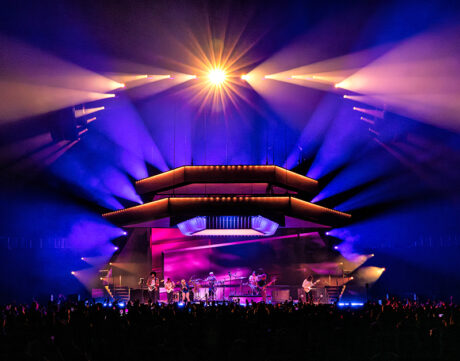
Collaborating with the Band
The design collaborative team of The Playground met with the members of the band to present their ideas and worked closely with the band throughout the design process. “We took them through the entire stage set up in person and showed them the design using VR goggles,” explains Routhier. “It was a really fun process. Once we were confirmed on the creative direction, we set up weekly creative calls with the band to make sure we had their input throughout the process.”
Cour Content’s Kluge has been working with Paramore since 2017. “On the content side, it’s been a super rewarding experience,” he says. “We bonded on a lot of levels aesthetically, so I’ve always just done my thing. I’ve worked with Zac and Hayley individually on their projects before and after Paramore, so we have that language and trust at this point. I think they like to work with people they trust and put them on a path; and for the most part let them express themselves, but they will definitely speak up if something is feeling like it’s heading in the wrong direction.”
For Lighting Programmer, Bobby Grey, meeting with the band—and hearing about the origins of specific songs—helped invest the team in the overall design for the tour. “It was really cool and refreshing to have the principals in the band come in, sit on a couch with us, and explain not just what they wanted to see in a song—but the rationale and history behind the song and why they wanted to see it a certain way,” he describes. “They took a direct interest in the aesthetic of the show, and that made us feel valued and vested in the success of the tour.”

Keeping it Fresh and Playing with Tints of Color
Creating different looks over the course of the performance can be a challenge to keep it looking new and different. Grey felt that Ahlstrand and Routhier’s geometric design was “really brilliant and versatile. We had a lot of layering to play with, and being able to reconfigure with automation was a huge plus as far as keeping things fresh from one song to the next. We were able to craft looks around the song and never felt boxed into a single look or feel.”
Routhier is a believer in allowing the music to dictate the creative direction for each song. “Music has shape and color. It’s just about finding the right shapes and colors that match the sounds,” she points out. “We also like to take the audience through a journey in every show we do. There are ups and downs, hills and valleys to the set list.” In terms of programming the lighting, Grey explains some of the color choices the team made for this tour. “At the band’s request, we leaned into a lot of shades of white,” he says. “This is where subtle nuance comes into play. Being able to craft a feel by sliding into off-whites—slightly CTO, slightly green, a kiss of CTB, without going into a saturated in your face color world can actually do wonders for the dynamics of a show because when you do plunge into a deep saturated look, the whole vibe of the room can change.”
The same careful planning comes into play with the content that’s created for the show. “Sooner has a very similar approach to me in terms of building a visual language and playing inside of that,” comments Kluge. “I was inspired by the design concepts for this show which were pulling from architecture, film, and also retro futurism. Sooner had proposed some designs that were based on production design from film and directors like Stanley Kubrick and Wes Anderson, which I was super inspired by. From there we made a storyboard first and planned out, song by song, ahead of time what will make each moment special. That way you don’t get in the weeds with programming and avoid making every look the same.”
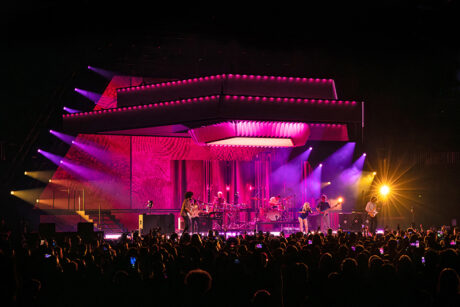
Building in Versatility
The versatility designed into the lighting rig offered the creative team a lot of latitude. “At first, when programming a show, it can be easy to find some things that work and lean into those and recycle them a lot,” explains Grey. “Thanks to Trevor’s vision and ingenuity, we were able to work together constantly to find new ways to utilize the rig. We were able to really focus on a vibe—both dynamically and architecturally—for each song. When programming it we tried to steer away from thwacking every snare hit, but instead ride the ups and downs and energy of the different songs. Having the combination of a ton of pixels in the rig, workhorse profiles, and elegant, indirectly lit set pieces with the [Martin] Sceptrons hidden by fascias, we had a ton of tools to reach for to create a lot of different looks.”
The lighting design for the show was “a combination of scenic pieces that acted as light sources, as well as using Robe Fortes and bright strip lights [JDC Line 1000 and impression X4 Bars] to accent the dynamics of the music,” describes Routhier. “The band’s music is high energy, and between the JDC Lines and massive Robe FORTE profile fixtures, we had the lumens to keep up,” adds Grey.
To light the scenic pieces to act as lighting fixtures, Routhier comments on some of the team’s key gear choices, noting “We relied heavily on Martin Sceptrons to light the fascias of the chandelier pieces. They were the ideal fixture as they’re low profile and can be hidden easily.” Ahlstrand came up with the idea to light the fascias of the trusses, which resonated with Grey. “Trevor’s idea to light the fascia of the moving trusses indirectly with Sceptrons read with elegance in the room. We could time sweeps, fades, peels, and chases precisely with the music and there was this feeling that they were self-illuminated at times.”
In addition to the Martin Sceptrons, the lighting rig for the tour included GLP JDC Line 1000 units, of which Routhier says, “The GLP JDC Lines were the perfect audience light for the show as well. They helped accent the horizontal lines of the trusses and filled the room with colorful light.” Grey concurs with Routhier, adding “The JDC Line 1000 is a fantastic new fixture. Having literally thousands of pixels that can both saturate into beautiful color, and pierce through from the white strip, gave us a myriad of options. Also, the [Robe] FORTE was an extremely impactful and bright workhorse profile. We could cut huge beams through the room—paint the stage with delicate patterns—bring in animation and fill the audience’s whole periphery with dazzling and sparkling texture, or even saturate them and not lose their impact in the air.”

Creating Content
It was Kluge’s first time working with Routhier and Ahlstrand, “but I think we instantly connected on the philosophy of merging lighting, video, and scenic altogether,” he states. “I don’t really think about content being a separate entity in a show design. So, in terms of content supporting the design I think it did that, as well as the other way around. There’s a moment at the beginning of “Figure 8” that I did this metallic object spinning and refracting, the lighting programming followed it. Things like that, I think, are what’s making shows more and more a fully immersive experience.”
Most of the content for this tour was made using Maxon’s Cinema 4D and camera effects were created with 10bit FX Limited’s Notch. He worked closely with Notch Designer and Programmer Brett Bolton on the Notch integration for this tour. “With Notch I used the NVIDIA Background Subtract [aka Background Removal] live for the first time,” says Kluge. “We used it to isolate band members and then put a layer of content between them and the background. The effect is kind of glitchy if you have a solid background, so I realized it would look better to have the original background but with some content overlays. It worked really well. I think my favorite challenge we addressed was the 3D house moment in ‘Liar.’ The band goes up on a lift and we built the Frank Lloyd Wright house from the This Is Why video around them, and it looked really cool in photos. We were talking about a photographable moment like this for a long time and it really turned out nice.”
When it came to a solution that addressed a design challenge for this tour, both Ahlstrand and Routhier responded mentioning, “scenic automation”. “The automation brought an incredible dynamic to the show,” states Ahlstrand. “We wanted to be able to light certain moments of the show with only the soft light directly over the band, allowing us to achieve a completely different mood. With the outer rings of the chandelier, we wanted to achieve some extreme angles and paint them in contrasting color. We wanted the looks to feel like something you would experience at an art installation.”
Routhier agrees with him, adding “The chandelier and automation were really the stars of the production. One of the biggest looks Trevor and I wanted to achieve was a ‘coin roll’ with the concentric trapezoid structures. We worked with Ryan Mast to achieve some dynamic movement throughout the rig. The soft box above the band was a statement piece that was able to hover over the band to create a beautiful glow in certain moments. The rings, and this soft box, helped create a ton of dynamics in the show.” PRG provided the automation and rigging for the Paramore tour.

Special Effects
Quite a few of the numbers featured some form of special effect over the course of the show—pyro and confetti. Ahlstrand points out that “there are so many fun stops and hits in the music that it was hard not to want to use SFX in most of their songs. We have a great mix of products, and we try to use them in a different location every time. Going into the final chorus of the first song is our first confetti hit, which helps add some visual energy to a song that starts off the set incredibly strong. Next, we have some gerbs that are shot from the truss flanking the screen on either side, when our automation is revealed, we have some mines that shoot in multiple directions off of the trapezoid, a beautiful waterfall for ‘The Only Exception’ and some trailing comets for the very staccato intro to ‘This is Why.’ Of course, some streamers and more confetti are used for the end of the show, printed with the lyrics ‘THIS’, ‘IS’, ‘WHY!’.” The special effects and pyro crew for the production were supplied by PyrotecnicoFX.
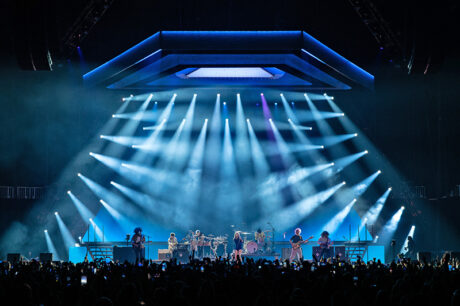
A Supportive Team
Along with PRG and PyrotecnicoFX as vendors for the tour, LMG Touring supplied the lighting and video. “Team LMG always comes through,” states Grey. “They’ve been a longtime vendor for Paramore through various creative camps and responded to everything we needed brilliantly.” Video Programmer, Ciara Hegli worked closely with Bryan Martinez at LMG “to create our media server rack that included two disguise media servers, a Barco E2, Blackmagic Videohub [12G-SDI video router], and a few more bells and whistles. They delivered a solid server rack that performed wonderfully all summer.”
On the scenic and staging front, Upstaging fabricated the fascias for the chandeliers. “Upstaging absolutely smashed the fascias for the chandelier,” Routhier comments. “I was skeptical about using soft goods as we wanted to have a nice, hard surface to make the system feel more architectural. They came up with a unique plan to deploy them and they always looked clean and crisp. SGPS was instrumental in making sure that the stage shape was adhered to. It was a unique one and they were able to replicate our drawings perfectly. The crew that SGPS sent on the road was also exceptional.”
The creative team for this tour worked well together and feel that the collaborative design and programming processes resulted in cohesive looking tour visuals that supported Paramore’s artistic vision and music experience they wanted for their fans. “I think the show has high quality programming all around,” says Kluge, “really strong lighting and video ideas from start to finish.” For Grey, it was the use of geometry and architecture in the show, and “how we leaned away from the kick/snare programming style and really tried to paint the dynamic base of the songs—making the moments we did accentuate look HUGE.”
For Routhier, she found satisfaction in the overall collaboration of the team and the band. “The collaboration process was amazing for this production,” she states. “Everyone’s ideas were heard and considered. I feel that proper collaboration really sets a production up for success. After all, we don’t all hear and see music the same way!” Hegli agrees, adding “Seeing the impact of the thoughtful design choices by this team every night on fans was incredible. Every show there was incredibly positive feedback from the crowd.” That, in the end, is the result that everyone is looking for—a very happy and satisfied audience.

VENDOR VIEW
LMG TOURING
Lighting & Video
LMG Touring provided video and lighting for this tour. The company has been working with Paramore since the 2017/2018 After Laughter tour. “The original plot for the ‘chandelier’ (the three large trapezoid shaped trusses that automate above the band) was originally designed as box truss, which would have really been difficult to load-in / -out in a reasonable time frame,” says Craig Mitchell, Managing Director for LMG Touring. “We were able to work up a solution using our Tyler GT Truss and custom corner blocks that allowed us to use pre-rig truss and still keep the unique shapes of the trapezoids. We prepped some of the overhead rig at the scenic vendor (Upstaging) as some of our lighting was integrated into the set pieces. With our Ross Carbonite Video package, we were able to automate the robotic cameras via switcher control and Video Director Adam Peck did some very impressive, pre-programmed looks with them.”
Mitchell and the LMG team worked closely with Tour Manager Andrew Weiss as well as PM Bybee, as well as Programmer Bobby Grey and disguise programmer Ciara Hegli on this tour. “I’ve always enjoyed working with Andrew, who has a long career in production,” says Mitchell. “He is extremely knowledgeable and a straight shooter. I had worked with Charlie Bybee on several previous tours, and we have formed a good working relationship over the years. The tour confirmed about 28 days from prep, so once we were confirmed, it was a big push to pull everything together for prep and rehearsals. Bobby Grey is a great programmer, always organized and his shows look awesome. Ciara Hegli is fast rising star in the touring media server world, and I look forward to her continued success.”
LMG Touring was very supportive of Production Designers, Routhier and Ahlstrand for this tour. “It’s always a pleasure working with Sooner and Trevor,” comments Mitchell. “Both are very creative and also understand the technical aspects of production, so what they design tends to translate well into the ‘real world.’ Sooner always has these massive looks without using a bunch a gear, and Trevor’s production design with the overhead scenic pieces really stood out. This tour had a lot of dynamic looks with the automated rig and some clever use of content as scenic for some striking acoustic moments.” Mitchell adds that, “Paramore is one of the best live bands out there and always put on a great show and connects with their audience. I’d like to thank our great tour crew for making these shows happened and our Lighting Crew Chief Joshua Dirks for being a super star throughout the run.” Being a full-service provider, LMG offers advantages to integrating multiple disciplines, and as they have multiple locations, clients can pick up on the East Coast and drop off at our West Coast location. The large LMG technical staff enables them to provide solutions and support to their clients on the road.
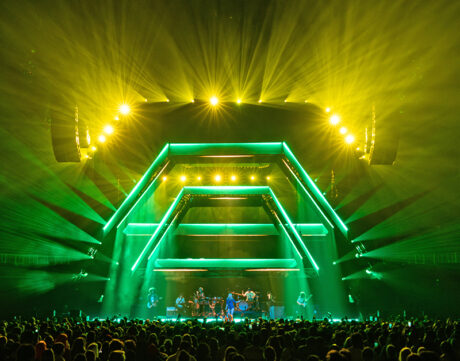
SGPS SHOWRIG
Staging
For Paramore in North America, SGPS provided the rolling touring stage deck painted a custom red, along with a custom bridge, barricade, and mast lift. For Paramore’s Australia/NZ leg, they again provide the custom red rolling touring stage deck along with the custom bridge and adding aerial automation, and two octagon stage lifts. “We were able to help the production out by designing and engineering a bridge platform that spanned 16’ unsupported,” explains Benjamin Lampman, General and Sales Manager, SGPS Showrig, Inc. “The way Sooner oriented the stairs made them look like they were magically floating. We were also able to help the production out with a last minute add of a stage lift. We have a large inventory of stock products which allows us to be able to assist with last minute requests. The mast lift we ended up using allows for the band to be loaded below the stage and then raised to stage level.”
Most the discussions SGPS had were with Production Manager, Charlie Bybee. “Charlie is great, and I cannot wait to work with him again,” notes Lampman. “Charlie knows what he needs and how to ask for it, so we were all working in the most efficient manner possible. He was great at keeping us apprised of changes and reasonable in making sure we had time to deliver the product right. Most of our design conversations were through [Technical Director] Matthew Geasey of Clear All Visual. We worked together on getting the red color on the stage correct and making the handrails that weren’t visually obtrusive on the bridge platform.”
Lampman sums up that “SGPS was right for the job because we have a great staging product that is sturdy and easy to set up. We are also not afraid of making custom bits to make a show look special. It was realized during rehearsal that the bridges need to be larger, so we built the pieces and sent a metal fabricator to site to help with install.”
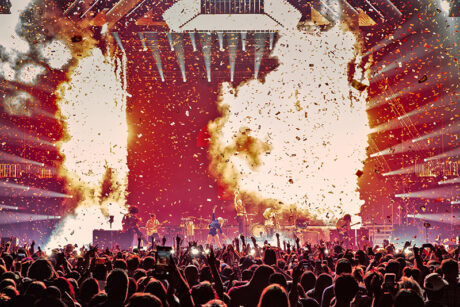
PYROTECNICOFX
Special Effects
For the Paramore tour, PyrotecnicoFX supplied the tour with special effects gear and crew, including pyro, confetti, and low fog solutions. “The cool thing about pyro on this tour was that every look was different, and the pyro originated from a different location on every song, which was kind of unique,” explains Rocco Vitale, VP of Live Events and Creative Director of PyrotecnicoFX, a LIVE EVENT Company. The company also supplied custom printed confetti for the last song, “This is Why.”
The PyrotecnicoFX Project Manager for this tour was Keith Hildebrand, “who actually shot [pyro] for Paramore when they toured last, about 10 years ago, says Vitale. “Keith has known [Tour Manager] Andrew Weiss for years. It was a kind of weird and funny at the same time. So, we had a person, on our team, who knew Andrew quite well already and had history with the band. It was great working on this tour; we started talking with the tour in May, and just between working with Andrew and Charlie [Bybee] and the great creatives, Sooner and Trevor, I felt like we had a really good, cohesive team working together. We all did a lot of good work together creatively with the pyro to make sure that the looks were all unique. That’s one thing I would say about this show, is that a lot of times you see pyro and it’s in one location and it shoots in the same location every cue for the entire show. This show was cool in the sense that every song had a different pyro location. That was something we worked really hard with Trevor and Sooner on and went through the whole show. We’re pretty adamant at our company that we do 3D renders of all our effects; giving them to the design camp to get their feedback.”
Vitale felt that PyrotecnicoFX was the right company for this tour as it was right in “our wheelhouse of our core competencies—pyro, confetti, streamers, fog. I think we had a good history. Keith had history with the band already, Sooner and I have worked on some projects together. It was just a good fit from the beginning, from my perspective, and it worked out in the end. It was great working with Charlie and Andrew.”
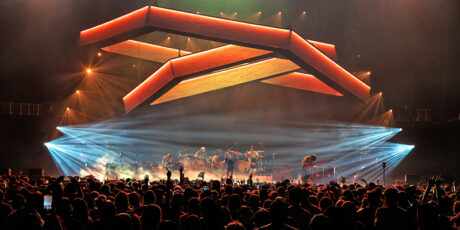
PRODUCTION TEAM
- Tour Manager: Andrew Weiss
- Production Manager: Charlie Bybee
- Production Designers: Trevor Ahlstrand, Sooner Routhier
- Creative Assistant: Allison Ciccarelli
- Technical Direction: Matthew Geasey, Bryan Seigel
- Lighting Programmers: Bobby Grey, Chris Smith, Nikita Jakovlev, Kyle Lovan
- Lighting Director: Chad Peters
- Lighting Crew Chief: Joshua Dirks
- Video Director: Adam Peck
- disguise Programmer/Op: Ciara Hegli
- LMG Technical Project Managers: Kevin Maas, Max Tuchman
- Content Director: Mike Kluge
- Notch Programming and Design: Brett Bolton
- Content Assist: Matthew Delisi
- Automation Programmer/Operator: Ryan Mast
- Automation Crew Chiefs: Jeff Archibeque, Caleb Darling
- Automation Operator: Sean Sweeney
- Grid Technicians: Caleb Darling, Conner Darling
- Automation Lead/Rehearsal Support: Matt “Skinny” Leroux
- Head Rigger: Derek Purciful
- SGPS Crew: John Purciful, Joe Darby, Angel Aguirre, Angel Pozos
- Pyro Crew: Sean Moore, Stepanie Woropay
- Stage Manager: Sam “Fish” Wilson
- Tour Coordinator: Brad Coletta
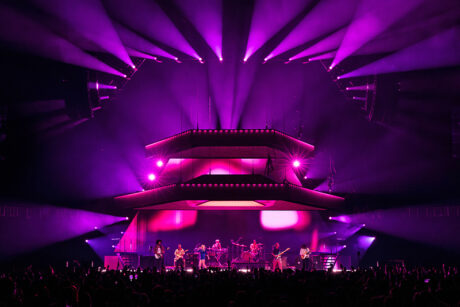
VENDORS
- Video & Lighting: LMG Touring / Craig Mitchell, Karol Luczkiewicz
- Automation & Rigging: PRG / Burton Tenenbein
- Scenic & Staging: Upstaging, SGPS / Ben Lampman, Alek Christman, Jeremy Brown
- SFX: PyrotecnicoFX / Rocco Vitale
- Trucking: 46 Logistics
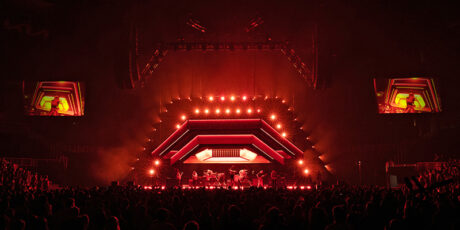
GEAR
Lighting
- 2 MA Lighting grandMA3 full-size
- 1 MA Lighting grandMA2 light
- 9 MA Lighting MA Networking Processing Unit
- 10 MA Lighting MA 8Port Node
- 2 Brainstorm Timecode Distripalyzer
- 6 Robe iFORTE
- 68 Robe ESPRITE
- 8 Robe MegaPointe
- 4 Robe BMFL WashBeam
- 12 GLP JDC1
- 12 GLP impression X4 Bar 10
- 53 GLP impression X4 Bar 20
- 43 GLP JDC Line 1000
- 8 Chroma-Q Color Force II 12”
- 2 Chroma-Q Color Force II 48”
- 12 Chroma-Q Color Force II 72”
- 24 Martin VDO Sceptron 10 320mm
- 92 Martin VDO Sceptron 10 1000mm
- 1 Martin P3-50 System Controller
- 4 Martin PowerPort 1500
- 3 Robe RoboSpot BMFL FollowSpot System
- 6 Robe BMFL FollowSpot LT
- 2 MDG theOne Atmospheric Generator Touring
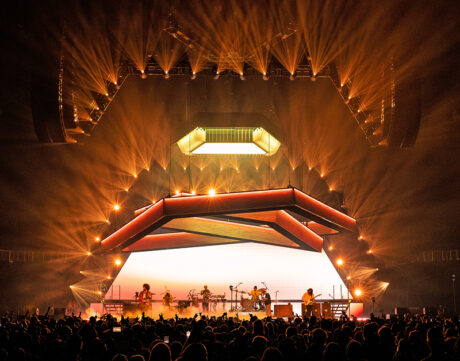
Video
- disguise GX3 Media Servers with Notch
- ROE Visual 5mm LED Upstage and Riser Screens
- 1 Ross Video 2ME Carbonite Switching Package
- 4 Panasonic 4000K Cameras Panasonic RQ32K 4K Laser Projectors
- 4 Panasonic 4K – PTZ Robotic Cameras
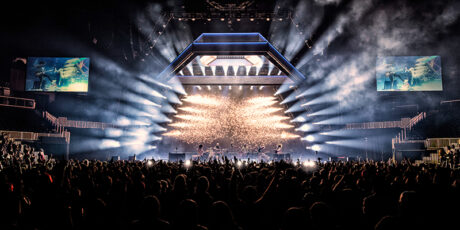
Automation
- 1 Kinesys K2 Control Wing
- 14 Kinesys 1-Ton Hoist
- 10 2-Ton CM Hoist
- 72 1-Ton CM Hoist
- 12 ½-Ton CM Hoist
- 4 ¼-Ton CM Hoist
- 11 Tyler GT Truss 10’
- 4 Tyler GT Truss 5’
- 2 Tyler GT Gate 30°
- 2 Tyler GT Gate 60°
- 7 Truss Box 20”
- 2 Truss Box 20”
- 16 Truss Box 12”
